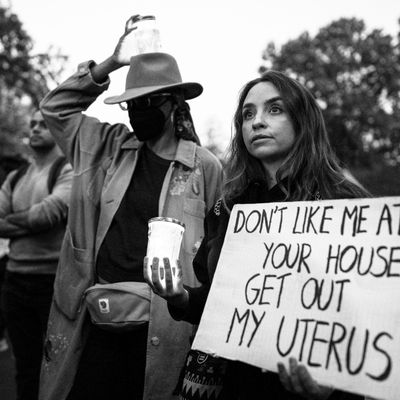
Anger over the Supreme Court’s looming abortion reversal arrived at Brett Kavanaugh’s door last weekend, thanks in part to the organizing efforts of his neighbor, Lacie Wooten-Holway. As a woman who has had an abortion and survived sexual assault, Wooten-Holway told the Washington Post she wanted the justice to know that disagreement with the Court’s apparent decision to overturn Roe v. Wade extends to his own neighborhood. Though some residents of Chevy Chase, Maryland, disagree with her “peaceful candlelit vigils” — “I think you vote, and you expand the Court. You don’t go to a guy’s house,” one man told the Post — she thinks a little discomfort is warranted. “We’re about to get doomsday,” she remarked, “so I’m not going to be civil to that man at all.”
Last week, a leaked draft majority opinion in Dobbs v. Jackson Women’s Health Organization — a case centered on Mississippi’s 15-week abortion ban — foreshadowed that the Supreme Court plans to not just revise Roe’s terms, but do away with them entirely. Justice Samuel Alito leaned heavily on anti-choice talking points and medical fallacies (as well as the musings of a 17th-century English jurist who did not support abortion but did support marital rape) in drafting his decision, and while the leaked version isn’t necessarily the final one, a second SCOTUS leak subsequently confirmed the Court’s intention. The conservative majority plans to let individual states decide if and when residents may terminate unwanted pregnancies.
As a result, the Guttmacher Institute predicts that abortion will become explicitly or effectively illegal across more than half of the country, and sooner than expected. The ensuing health crisis will affect everyone, regardless of where they live, as patient overflow from shuttered clinics in the most restrictive regions ripples out to the coasts. As more people are made to give birth without the resources to care for themselves and their infants, we can expect unconscionably high maternal mortality rates to climb and the poverty gap to widen (particularly along existing racial lines). The majority of U.S. adults continue to believe abortion should be legal in all or most cases, and many people grappling with the implications of a future without Roe are angry. The weekend saw protests nationwide, in major cities as well as outside select justices’ homes. One group of about 100 people marched from Kavanaugh’s house to Chief Justice John Roberts’s residence on Saturday, reportedly reserving the bulk of their ire for Kavanaugh. On Monday night, another crowd arrived at Justice Alito’s home.
These demonstrations remained peaceful, though they may not have been entirely legal. Still, as the Boston Globe notes, it’s not immediately clear that the intended recipients of the public’s feedback were even home. But the point was to bring public opinion straight to the justices’ doors; to put discontent on display where it could not be ignored. The Supreme Court itself received a protective ring of unscalable fencing in the days after the draft opinion leaked, placing a buffer zone between the people who made the decision and the people who will have to live with it. On the right, concerns about the leaker’s motives focused on the safety and sanctity of the Court. Some have compared the weekend’s protests to the Capitol insurrection. Others just seem sensitive to criticism: The Bangor Daily News reports that Maine senator Susan Collins called the cops over sidewalk chalk that read, “Susie, please, Mainers want WHPA,” referring to the Women’s Health Protection Act, which would codify Roe at a federal level.
That one side of the aisle is now indignant about Kavanaugh’s inalienable right to privacy is predictable, if also ironic: Roe’s central premise holds that the right to privacy means women get to make their own decisions about their own bodies. But even the response from Democrats misses the point. President Joe Biden “strongly believes in the Constitutional right to protest. But that should never include violence, threats, or vandalism,” White House Press Secretary Jen Psaki tweeted Monday. “Judges perform an incredibly important function in our society, and they must be able to do their jobs without concern for their personal safety.” Democratic senator Chris Murphy told Fox News Sunday: “I’ll be honest, I’ve had protests right around the corner from my house over the course of my time in public service. But any threats of violence are beyond the pale.” Senator Dick Durbin reportedly said at a Senate Judiciary Committee meeting on Thursday: “I think it is demeaning and adolescent and not convincing at all when you’re trying to plead your case by doing something that outrageous.”
It does not appear the protesters who gathered outside the Kavanaugh and Roberts households advocated for, or threatened, violence. It seems like they mostly shouted slogans like, “Abortion rights are human rights,” and, “Pro-life is a lie! You don’t care if people die!” If we are going to talk about violence, though, deliberately stripping a group of their rights and forcing them to give birth comes closer to the mark.
But as Democratic leaders scold protesters for exercising their right to assembly the wrong way, they don’t acknowledge why it has come to this. On Monday, the Senate passed a bipartisan bill beefing up security for the justices, with no objections; meanwhile, Senate Majority Leader Chuck Schumer only brought the WHPA up for a vote on Wednesday. It didn’t pass. A Democrat-controlled Congress could summon up urgency when it came to justices facing pushback for revoking the right to bodily autonomy, but it couldn’t muster that same energy for the right itself.
The suggestion that we can just vote this problem away ignores the fact that the people who promise to fight for abortion rights have failed again and again to uphold them. Sticking to the accepted channels doesn’t seem to effect much change, and then, the justices’ comfort shouldn’t take top priority. If Kavanaugh and his colleagues were indeed home for the vigils, whatever fear and anger they may have felt while looking out at their front lawns is a tiny sliver of the fear and anger they have inflicted on millions of people. Their decision will disrupt countless lives. Theirs can withstand a little disruption, too.





